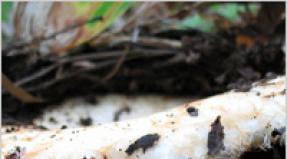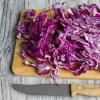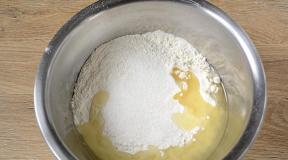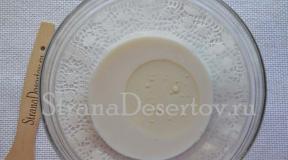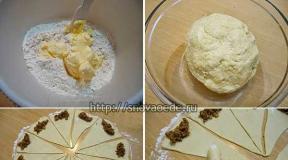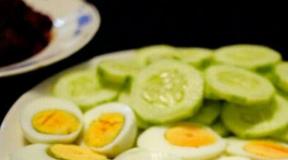The most delicious instant sauerkraut crispy and juicy: easy recipes with step by step guide. How to ferment cabbage at home for the winter in different ways Sauerkraut in a quick way without vinegar
In winter and early spring, we experience vitamin deficiency, which is caused by a lack of sun, fresh vegetables, berries and fruits. Sauerkraut can easily replace most of these foods, providing our body with tremendous benefits. Since it contains not only very useful vitamins (C, P, B, A, H, E, K), but also important trace elements (iron, magnesium, potassium, calcium, phosphorus, sodium, sulfur, zinc, chromium, iodine, copper, molybdenum, etc.).
Not so long ago, this product was harvested for the winter only in the fall, and the whole family usually took part in the procurement of winter stocks. It was fermented with the addition of carrots, beets, various berries and fruits, for which it was chopped, chopped into pieces, quarters (pelyus) or whole heads of cabbage were used. Ready cabbage can not only be served with butter and onions, but also cooked from it, main dishes, used as a filling for dumplings, pies and pies, and even boiled or cabbage soup.
Today I will introduce you to various ways to prepare this very tasty snack for the winter.
For your information, the recipes below will remain relevant in the winter, as cabbage and carrots are now sold in stores all year round.
The first recipe that I want to introduce you to is the classic white cabbage fermentation technology used in canning industries.

Currently, the most common way to prepare this snack is the shredding method. Vegetables are fermented usually in barrels, vats, plastic or enameled dishes.
For fermentation for the winter, you need to choose the right vegetables. Not all varieties are suitable for this purpose. Usually, mid-ripening and late-ripening varieties are used (for example, Slava, Belorusskaya, Moscow late and others).
Early maturing varieties are undesirable for use, as they usually have a loose, loose structure and a low sugar content necessary for fermentation.
I choose white heads with a dense juicy structure for fermentation, since vegetables that are not very juicy will give little juice, and the fermentation process will be complicated.
To prepare this appetizer according to the classic recipe, we need carrots, salt and spices as additional ingredients. I usually take 1 medium-sized carrot for 1 large head of cabbage, but since such concepts as large, medium are different for everyone, for convenience, I will indicate all proportions per 1 kilogram.

Ingredients:
- Cabbage - 1 kg
- Carrot - 30 g
- Salt - 20 g (per 1 kg of vegetables)
- Dill seeds - 0.5 tsp
- Bay leaf
First, we clean the heads of cabbage from the outer green leaves and from all visible damage and wash well. Then carefully cut out the stalk with a knife and chop. When chopping, if possible, straws of uniform size should be obtained.
My carrots, peel from the top layer and grate or cut into thin strips. The color of the finished product depends on the amount of carrots. The more it is, the brighter the shade. However, there should not be too much carrots, otherwise it will give the finished dish extra softness.

Mix all vegetables and rub with salt. Salt is added in the amount of 20 g per 1 kg of vegetable mixture.
When pickling cabbage, salt is added at the rate of 2-2.5% by weight of vegetables.
If you add more salt, then the finished dish will be oversalted. Also, an excessive amount of salt will inhibit the activity of lactic acid bacteria, and then other microorganisms that are undesirable for us may develop in the product.
However, if the amount of salt is less, then the finished product, due to the action of foreign microorganisms, may be too softened and may become covered with mucus.
It is impossible to use iodized salt for fermentation, otherwise the cabbage will turn out soft.

Now we transfer the vegetable mixture to a large container, and tamp it well with a wooden pestle or rolling pin. In the middle of the vegetable mass we place several bay leaves and dill seeds wrapped in gauze or a bandage. Dill will give the finished dish a piquant flavor, in addition, it has antibacterial properties, which will prevent the growth of putrefactive bacteria.
If desired, you can put whole leaves on top, which must be prepared in advance by removing them from the washed heads.
I don't use whole leaves because it's not convenient to pierce the vegetable mixture afterwards to remove any accumulated gas.
Finally, we put a wooden circle or a flat plate on top, the diameter of which should be slightly smaller than the diameter of the container itself, and put a load (for example, a jar of water or a clean calcined stone). The oppression should be heavy enough that the mixture settles and becomes covered with brine.
We simmer the cabbage for several days at room temperature. The fermentation process starts almost immediately. After a few hours, juice appears on the surface.

We pierce the fermented vegetable mixture in several places daily (morning and evening) with a wooden stick, knife or fork. It does this in order to release the accumulated gas released during the fermentation process. If this is not done, the finished product will acquire an unpleasant odor and bitterness.
On the second day, foam appears above the surface of the brine, which must also be removed as it forms.
Favorable temperature for fermentation is in the range of 15-22°C. If the temperature is below 15 ° C, then the fermentation process will be greatly delayed. At temperatures above 25°C, along with lactic acid bacteria, microorganisms harmful to the fermentation process will also develop, under the influence of which the finished product will acquire an unpleasant taste and smell.
At a temperature of 20-22 ° C, vegetables are fermented already on the fifth day, acquiring a pleasant sour taste. The brine will become clear by this time. At lower temperatures, the fermentation process can last up to 10 days.
Considering that everyone has their own taste preferences, you can control the sour taste of the finished dish by taking a sample, starting from the 3rd day.

As soon as the appetizer acquires a pleasant taste and sufficient sourness, the containers are removed to a cool place (cellar or basement). I transfer the finished snack into three-liter jars and put it in the refrigerator.
Sauerkraut with beets (in a 3 liter jar)
Of the incredible number of recipes for making sauerkraut, beetroot fermentation is perhaps the best of them. That is why it is very popular, because of the amazing taste of the finished product and the ease of preparation.
We will prepare an appetizer according to this recipe in a 3-liter jar. The dish turns out moderately spicy and beautiful in appearance.

To prepare this dish, I took a large Slava fork, one medium maroon beetroot, which turned out to be very sweet in taste. I indicate the amount of ingredients for one 3-liter jar.

Ingredients:
- Cabbage - 2.5 kg
- Beets - 1 pc. (medium)
- Sugar - 1 heaped tablespoon
- Hot pepper - 1 pc.
- Garlic - 5 cloves
I washed the fork, removed the upper leaves, cut it into two parts and removed the stalk. Then she chopped it with a knife into medium-sized straws. The beets were washed well with a hard grater, cleaned and chopped on a coarse grater.

The garlic was peeled and finely chopped with a knife. Washed hot pepper, removed seeds and partitions and finely chopped.

In a large container, I combined all the vegetables with salt, sugar, spices and mixed well.

I prepared a 3-liter jar in advance and washed it thoroughly. She laid out the vegetable mixture in a well-washed jar, tamping it tightly with a wooden rolling pin. I put the jar in a deep plate, because during the fermentation process, the juice flows out of the jar.

I’ll make a reservation right away that I put the chopped vegetables in a jar in two stages. First, I filled the jar and waited 20-30 minutes for the vegetables to release their juice and the mixture to settle a little. Then I added the rest of the vegetables.
Since the beets were sweet enough, the fermentation process was stronger. Foam appeared on the surface of the brine by the next morning.

I pierced the contents of the jar daily (morning and evening) with a large knife. Also in the morning and in the evening I removed the emerging foam.
Fermentation took place at a temperature of 20-22°C. On the fourth day, the fermentation process slowed down, and the appetizer was almost ready. I covered the jar with a nylon lid and put it in the fridge for storage.

The appetizer according to this recipe is a little spicy and can be stored in the cold all winter. It can be served on the table with vegetable oil and herbs.
Crispy sauerkraut for the winter (instant recipe in jars)
And here is another recipe for this wonderful dish. We will also ferment vegetables according to this recipe in jars.
We take ripe forks of late varieties, mid- or late-ripening carrots (it has a richer color and sweetness), salt, sugar and bay leaf.

Ingredients:
- Cabbage - 5 kg
- Carrots - 150 g
- Salt - 100 g
- Sugar - 100 g
- Bay leaf - 5 pcs.
- boiled water
We clean the heads of cabbage, wash them, remove the stumps. Next, chop or chop them. Wash the carrots under running water, peel the skin and rub on a coarse grater.

We mix the prepared vegetables in a large container, grind with salt and fill the prepared jars with the resulting mixture, adding one bay leaf to each. No need to tamp. The vegetable mixture should lie loose.

Pour the vegetable mixture in jars with cold boiled water, cover with clean gauze and leave in a warm room.
Banks must be placed in a deep container (plate or basin), as the brine will flow out of the cans as fermentation progresses.
Fermentation time is approximately three days. Every day (morning and evening) we pierce the contents of the cans in several places, and also remove the emerging foam. Drain the resulting brine back into the jars.
After three days, drain the brine from the jars through cheesecloth into a saucepan, dissolve sugar in it, pour it into jars again, close them with plastic lids and put them in a cold place.
When adding sugar to the brine, you need to taste it. I like sweet and sour, so I add sugar to the brine until it tastes sweet.

After 8-10 hours, the snack is ready. It turns out crispy, slightly sweet, and you can serve it on the table without dressing it with anything.
How to quickly and tasty ferment cabbage in brine
Another option for preparing this wonderful snack is fermentation in brine.
I took a large fork of the late Slava variety, which turned out to be strong and juicy, and one carrot of the Karotel variety, which has a sweet pulp of a delicate taste, juicy and crispy.

Ingredients:
- Cabbage - 2.5 kg
- Carrot - 1 pc. (medium)
- Salt - 2 tablespoons with a hillock
- Sugar - 2 tablespoons with a hillock
- Bay leaf - 2 pcs.
- Allspice peas - 6 pcs.
- Water - 1 l
I chopped the washed prepared vegetables and mixed them thoroughly in a large bowl.
Try to chop with thin straws. Finely chopped cabbage will ferment faster.
I laid out the vegetables in a pre-prepared 3-liter jar, tightly tamping each layer with a wooden rolling pin. Already during this action, juice began to stand out from the vegetables.
This is a good signal, which means that during fermentation, the contents of the jar will be completely covered with brine.


Adding sugar to the brine speeds up the fermentation process.
As soon as the brine cooled down, I filled them with vegetables in a jar. I put the jar in a deep plate, because during the fermentation process, the juice flows out of the jar.
In the morning and in the evening, the contents of the jar were pierced with a knife to release the bubbles of the gas released during fermentation to the outside, and the resulting foam was removed.

After two days, my snack had enough acidity for my taste and was completely ready to eat.

I want to note that this recipe is suitable for those who live in a city apartment, and they do not have the opportunity to store blanks in the basement or cellar. According to this recipe, you can ferment vegetables all winter and spring as they are eaten.
Recipe for homemade sauerkraut in a pot, like my grandmother
There are many recipes for this wonderful appetizer, but the cabbage my grandmother fermented the old Russian way was especially good. Do you want to cook the same?

Ingredients:
- Cabbage - 10 kg
- Carrot - 200 g
- Salt - 200 g
- Sugar - 2 tbsp. l.
- Dill seeds - 1 tbsp. l.
- Bay leaf - 3-5 pcs.
If your total fork weight is more or less than 10kg, calculate how much salt you need for your quantity.
We wash the heads of cabbage well, remove the stalks and, setting aside a couple of small heads of cabbage to the side, cut into strips using a shredder or knife. Wash the carrots thoroughly, peel and rub on a coarse grater or cut into thin strips. The remaining heads of cabbage are cut into 8 parts each.

Add grated carrots, salt, sugar to the chopped mass and mix, rubbing lightly with your hands.
Now we shift half of the vegetable mixture into a large enameled pan without chips and tamp well. Next, lay out evenly chopped heads of cabbage, 3-5 bay leaves, dill seeds wrapped in gauze or bandage and the remaining half of chopped vegetables.

We tamp everything tightly, cover with a wooden circle or a flat plate and press down with a load.
We cover the pan with a towel or napkin, as the vegetable mixture needs to breathe, and leave it for fermentation at room temperature (20-22 ° C).
In the morning and in the evening we pierce the contents of the pan in several places. We also remove the emerging foam daily.
After 5-7 days, as soon as the brine becomes transparent, and the product acquires a pleasant taste and sufficient acidity, we remove the pan in a cool place (cellar or cellar).
If you want the vegetables to be slightly acidic, then start sampling from the third day of fermentation.
My cabbage acquired the desired taste on the fourth day of cooking.

By the way, ready-made sauerkraut can be stored in the cold until spring, preventing it from defrosting.
We used to, in the absence of a cellar, kept it on the balcony. If it thaws, then it is necessary to use it in the near future, because in this case the finished product changes its structure and becomes soft, not crispy and quickly deteriorates.
Video on how to ferment cabbage without salt and sugar
Now that we have learned how to cook this appetizer without salt and sugar, I will tell you how you can diversify its taste by adding fruits and berries.
Delicious cabbage pickled for the winter with apples, cranberries and rowan
Now that we have prepared with you enough of an easy-to-make, but nevertheless wonderful snack, let's try another wonderful recipe.
We will make sauerkraut with apples, cranberries and mountain ash.

Ingredients:
- Cabbage - 3 kg
- Carrots - 3 pcs. (large)
- Salt - 70 g (20 g per 1 kg of vegetable mixture)
- Cranberries - 200 g
- Rowan - 200 g
- Apples - 2 pcs.
- Allspice peas - 0.5 tsp.
- Black pepper - 0.5 tsp.
For this recipe, we will use white cabbage of winter varieties (I have one large fork weighing 3 kg), carrots, cranberries, mountain ash and sweet and sour apples. I used the Semerenko apple variety.

I removed a few top leaves from the prepared fork, cut the rest into several large pieces, cut out the stalk and chopped it with a knife into thin strips. Grated carrots on a coarse grater.



Then she began to lay out the vegetable mixture in layers in the pan, tamping it tightly and shifting it with apples and berries.

With the last layer, I laid out the rest of the vegetable mixture, tamped everything tightly again, covered it with a flat plate, pressed it down with a load and left it to ferment at room temperature.
I pierced the contents of the pan daily (morning and evening) in several places with a knife in order to release the accumulated gas.

After three days, the appetizer acquired the desired taste, I put it in glass jars and put it in the refrigerator for storage.

You can use the cabbage prepared by us according to these recipes in different ways: as a snack, simply season with onion and butter; as a filling for dumplings, pies and pies; cook cabbage soup and; fry, stew and bake, serving as a side dish for meat and fish dishes.
In contact with
Warm greetings, dear readers! Everyone is familiar with the autumn time, when jars, pots with brine begin to reign in the kitchen, and all this in order to accomplish the sacrament of cooking sauerkraut, which must first be infused overnight (or even day) and only then will be ready to go to your table . Today I will tell you an easy step-by-step recipe for instant sauerkraut in brine, which will allow you to serve cabbage on the table this evening (looking ahead, I will say that the secret lies in the marinade - with vinegar and ... what? That's right, oil).
Ingredients:
- Cabbage (regular or white) - 1.5 - 2 kg
- Carrot - 2 pcs.
- Garlic - 6 cloves
- Salt, sugar - 2 and 3 tbsp. spoons respectively
- Water - 1 l
- Allspice - 2 pcs.
- Bay leaf - 3 pcs.
- Vegetable oil - 150 g.
- Vinegar - 150 g.
Time: 120 minutes
Cooking:
Firstly, washed cabbage cannot be rubbed or crushed, only cut into strips, rub the peeled carrots on a coarse grater (or Korean), garlic in a garlic press.
Secondly, brine. We add spices, salt, vegetable oil to the water and put on fire, bringing to a full boil, as soon as the marinade starts to boil, add vinegar, mix. Always taste it, as it may not be salty enough or you may want to add a little more pepper, spices.
Such cabbage can easily compete with traditional Korean salads and will not mind at all if you wish to add a little Arabic charm to it with coriander (ground) and red pepper. What if?..
Yes, the above recipe is beyond praise and helps to brighten up any day if you suddenly want juicy and crispy cabbage. You can also cook it without oil and vinegar, this will not affect its taste in the least, but the cooking time will increase from two hours to a couple of days - as a result, classic sauerkraut will be waiting for us.
Even in such a brine without vinegar, you can add honey, which will add spice and sweetness to the cabbage.
Seoul Recipe
Korean cabbage - so spicy and spicy - it's impossible not to fall in love with it the first time. By itself, it is very easy to prepare, does not require much effort and time, which is undoubtedly its advantage, just like the bright burgundy pieces obtained after cooking. And, of course, let's not forget about the high content of vitamin C, which makes our snack not only tasty, but also healthy.
Time: 2-2.5 hours
Servings: 4 guests
So, for this in the store you should get:
- A head of cabbage weighing approximately 2 kg
- Beets - 1pc
- Garlic - 5 teeth
- Sugar - 3 tbsp. spoons
- Coarse table salt - 3 tbsp. spoons
- Pepper (black) - 10 peas
- Bay leaf
- Vinegar 9% - half a glass
50% of delicious pickled cabbage with beets is a properly prepared marinade. We collect water in a saucepan and put it on medium heat. As soon as the water begins to boil, add sugar, salt, bay leaf and pepper, cook for about fifteen more minutes, stirring. Vinegar is added only after removing the marinade from the heat.
- We cut the cabbage into large pieces, while not forgetting to remove thick veins (as well as rumpled or rotten places, if any).
- We chop the beets almost into straws, although, for example, I prefer to just cut them on a Korean grater - it's faster and more convenient.
- We clean the garlic and cut it into several pieces (as a result, thin semicircular pieces are obtained).
- We put all of the above in a three-liter jar, while mixing, shaking.
- Pour the marinade so that all the vegetables “drown” in it and close the lid.
There is not much difference in pouring cabbage with hot marinade or chilled, only that if the hot marinade gets on the glass, the jar will immediately burst in your hands. To prevent this, use a special vent or a large spoon.
Let it brew and you're done!
Ways to prepare sauerkraut with apples
Ahoj, regular readers and guests! Today I want to continue our conversation about sauerkraut and pickled cabbage, and especially for this I have prepared as many as five very tasty recipes, according to which my grandmother has long been preparing salting for the winter. They differ not only in the originality and surprise of the ingredients, but also in vitamins, which are even more due to the combination with berries or fruits, such as sauerkraut with apples.
Honey
Indeed, which of us does not associate honey with winter? Dark, cold evenings with a cup of tea, at the bottom of which lies a spoonful of honey, which has preserved those beautiful sunny May days when it was collected. And immediately the taste changes, it becomes sweet-spicy, and you seem to look back into the summer for a second ...
That is why this recipe is first on my "winter" list.
- Fresh head of cabbage (white)
- Carrot - 1 pc.
- Garlic - 2 cloves
- Apple - 1 pc.
- Mustard seeds - 1 teaspoon
- Bay leaf - 3
- Dill
- Black pepper
- Honey (preferably candied) - 2 tsp. spoons
- Salt to taste
- Vinegar - 2 tbsp. spoons
Marinade.
I always start with it, since almost 70 percent of the taste depends on this particular stage of work, a good marinade can save even cabbage or carrots “with flaws”. Pour water into the pan, add two teaspoons of honey, salt, peppercorns. We put on the stove and cook over moderate heat, occasionally you can stir. Keep on fire until full boil.
Cabbage.
Be sure to wash it, cut off the top leaves and chop in half. We examine the inside for any damage, rot or other troubles (each one must be removed!). I always cut the cabbage into thin, thin strips, as far as possible, too long slices can be cut in half, or vice versa, left.
Garlic and apple.
Peeled garlic does not need to be finely chopped, it is enough to chop into several parts. Remove the skin from the apple, cut around the core with seeds. The resulting pieces can be left as they are, but I prefer to cut a little more.
Carrot.
Rinse in cold water, clean (I use a dishwashing sponge, hard side), and then grate. It is best, of course, to use Korean, but if it is not there, it is quite possible to chop thin “sticks” on your own.
Jar.
All the resulting stuff is poured into a jar of three liters, there is also a bay leaf, dill and mustard seeds. Tamp tightly. Pour the cooled marinade completely, so that all the vegetables are in it, cover with a lid and leave it on the balcony. The future snack should be infused for about a day, become darker and tastier from honey.
Such a simple recipe in a jar is suitable for any apartment, as it does not take up too much space in the end.
Apple orchard.
Apples are something that is always associated with the end of spring, summer. As soon as ripe, ruddy, shiny with juiciness and freshness appear, you just look at them and already think about how cool it would be to bite off at least a little bit.
What about cabbage and apples? I don’t know a single recipe that would give it such a summery bright taste, such juiciness and ennoble acetic sourness.
- Carrots - 400 g
- Bay leaf
- Sugar
- Apples - 4 pcs.
- White cabbage - 1 medium head
- Peppercorns, black allspice - to taste
Cooking:
- Wash the cabbage, remove the “outer leaves” and all the imperfections (if any), chop into strips.
- Wash the carrots, grate on a Korean grater.
- We mix them with cabbage in a bowl, add sugar, laurel and squeeze well, so that the vegetables release the juice. A little peppercorns for the last
- Peeled apples with pits removed cut into equal slices.
- We spread everything in a jar gradually, in layers. Cabbage-carrot layer, apple layer. We alternate until the very end. Fill with hot water, cover with a lid.
- We leave the appetizer for three days, after placing the jar on a tray or in a bowl (water will leak during fermentation). Once a day, pierce with a toothpick to let the fermentation products come out.
Autumn.
I love this method for its sophistication and special taste, which I call “autumn”. If cabbage with apples or honey is always a memory of summer, then with cranberries - October, early November. Golden leaves, rains, gray skies... This wonderful kind of romance.
- Cabbage - 1 k.
- Apples - 3 pcs.
- Cranberries - 300 g.
- Carrots - 2 pcs.
Cooking:
Prepared in enamelware under pressure. All ingredients must be washed, cleaned and chopped. The bottom of the dish is laid out with leaves, on top of them a “mix” of apples, cabbage and carrots chopped into strips is sprinkled with cranberries on top. It is also covered with cabbage leaves and put under oppression for 24 hours.
french
This cabbage differs from cranberry only in that we must replace the autumn berry with raisins. In general, the principle of preparation is absolutely the same, but the result is completely different.
ancient
The peculiarity of this method is the place of the leaven in the barrel. Having prepared everything you need, chopping cabbage, carrots and other vegetables, you need to scald the tree with boiling water a couple of times and only after that spread the cabbage. A “lid” is placed on top of it, and it is oppressed. The barrel should stand at a temperature of no more than 0 C. The fermentation time is 2 weeks.
In Russia, not only bread, but also cabbage has always been revered. Fresh, and even more often fermented, it was served at the table. In fact, it has become our traditional product. Forgetting traditions is not good, so once again I want to recall a few classic recipes for fermenting white cabbage at home.
Photo: https://i.ytimg.com/vi/MhmC-FWh0lY/maxresdefault.jpg
fermentation is a natural fermentation process caused by lactic acid bacteria. The acid that is produced during this process is not only an ideal preservative, but also a tool for suppressing the growth of pathogenic bacteria, of which E. coli is a typical representative. When it comes to harvesting vegetables for the winter, there is simply no better way than pickling. When fermenting vegetables, much less salt is added than when canning, and vinegar is not used at all, which is necessary for pickling.
And you can’t even list how many culinary masterpieces you can cook with it! In the first place, of course, are the first courses, and these are cabbage soup, red borscht with sour cream and solyanochka! From the words alone you already feel their pleasant smell and incomparable taste.
And then what? Please, here's a vinaigrette for you, and stewed cabbage under a tomato with an onion! And you can boil a couple of sausages with them. You can roll up a roll, where its sweet and sour taste will pleasantly complement this insipid cake. And best of all with an onion and butter for boiled potatoes - this is not a dish, but just a fairy tale.
You can come up with an original recipe for the dish yourself. But before you create it, let's learn how to sour, because there is nothing better than having your own homemade sauerkraut on hand.
A classic recipe for delicious sauerkraut at home.
In order not to deviate from the classic recipe, we need:
- White cabbage,
- fresh carrot,
- coarse salt,
- granulated sugar.
If you wish, then dill seeds, bay leaf, cranberries and black peppercorns can be added to the above ingredients.
Only varieties of mid-ripening and late-ripening white cabbage are suitable for pickling. Heads of cabbage should be elastic, tight, and the vegetable itself should be slightly sweet in taste, juicy and crispy. It should not have green leaves, and its cut in color should resemble a creamy white shade. Rock salt must not be iodized or the final product will be slightly bitter, off-flavour, and not crunchy.
Attention! Only enameled dishes (buckets, pots, tanks) or glass jars are suitable for pickling!
How to ferment cabbage?
- Empty the kitchen table completely (the extra space will not hurt us). Take a head of cabbage and remove the top leaves from it.
- With a regular knife or a special shredder, cut it into strips of 5 mm width. Remove the stalk.
- Grate the carrots on a coarse grater or chop them into thin strips. Put in the seasonings. For 1 kg you need 20 gr. salt (a tablespoon without a slide) and 30 gr. carrots.
Attention! Once again, pay attention to what kind of salt you add. If it is iodized, then after pickling, the cabbage will have a bitter taste and an unpleasant odor.
- Someone considers this activity the most difficult, but it is even very pleasant when all the ingredients are mixed and rumpled with hands until the juice is released. A large volume must be divided into portions and all manipulations should be carried out with each portion separately.
- Take the prepared enameled (glass) container and tamp the cabbage there. To do this, use, for example, a pusher. You can simply tamp with your hand or fist until cabbage juice appears on the surface. Take a cloth napkin, put it on top of the mass, then cover everything with a plate and press down with oppression so that the juice comes out. Just set the container aside, because. fermentation will take place at room temperature.
- So that the final product is not bitter, it is necessary to pierce the mixture to the bottom with a long wooden hairpin every day. With this action, we will release gases that are formed during fermentation. If foam collects on the surface, it must also be removed.
- The fermentation process takes from 3 to 5 days (it all depends on the temperature in the house). Readiness is always determined by taste.
 Photo: https://vkusnatisha.ru/wp-content/uploads/2017/10/8.jpg
Photo: https://vkusnatisha.ru/wp-content/uploads/2017/10/8.jpg Then the finished yummy should be removed to a cool place (refrigerator, closet, balcony), but not in the cold, because. how too much cold and heat make her soft. The optimal storage temperature is considered to be from 0 to 5 C.
Agree that it is quite simple to ferment cabbage at home. There are other ways of sourdough, which we will also pay attention to.
Sauerkraut with brine
This recipe does not require any physical effort from you. Take 2 medium-sized heads of white cabbage and, as in the previous recipe, chop it.
Then add carrots chopped on a shredder designed for Korean carrots. Beautifully chopped vegetables stimulate the appetite. Mix the ingredients and squeeze them a little.
Then we shift everything into a pickling container and also tightly tamp it with our hand or any device (crusher).
Brine preparation
For the brine you will need:
- 2 liters of cold water, but not from the tap, but spring,
- 4 tbsp. lies. coarse salt,
- 2 tbsp. False granulated sugar.
Mix the ingredients until completely dissolved and pour the resulting brine so that it covers it. Cover with a plate on top and press down with a weight.
After 3-4 days, we transfer it to another container, having previously removed the load and let it stand for another 10-12 hours. This must be done in order to remove excess bitterness from the product.
 Photo: https://fermer.blog/media/res/8/1/7/2/9/81729.ps0en0.840.jpg
Photo: https://fermer.blog/media/res/8/1/7/2/9/81729.ps0en0.840.jpg Now you can arrange the cabbage in jars. And there is a little secret here: before laying it down, squeeze it slightly from the juice, because when you pack it into a jar, there will be enough liquid for further storage.
This proven recipe will not disappoint you. To store cabbage cooked in brine, the same principle is used as for sauerkraut cooked in the classical way.
How to ferment cabbage in a folk way - video.
This recipe is very simple, but believe me, our ancestors have used it since ancient times. At the exit, it is worthy of the royal table: it is juicy, beautiful, crispy. It is good that the recipe has survived to this day, and we can use it.
And a little more about sauerkraut
During fermentation, cabbage cannot be subjected to heat treatment, which means that all useful vitamins and trace elements are not destroyed, and the product retains its beneficial properties. The shelf life can be up to 10 months.
Fermentation rules require that this process last from 3 to 7 days. To speed up the fermentation process, some manufacturers add vinegar. It is ready after 2 days, but the benefits of such a product are minimal, and the taste is not at all the same as the real one.
Some housewives prefer to add sugar to speed up the fermentation process. But the whole point is not to speed up the cooking processes, but to make them go their natural way. And you can sweeten the dish before serving.
The fact that you have a quality product in front of you will be indicated first of all by the color of cabbage (light straw, yellowish) and its taste (should be juicy, crispy, sour-salty, but not vice versa). These rules must always be observed, regardless of whether sauerkraut was made under industrial conditions or at home.
The addition of spices and seasonings during sourdough affects the color tone. It is advisable to observe the width of the shredded strips (approximately 5 mm). If they are smaller, then useful microelements will be preserved worse, and if they are larger, then they will not look so appetizing. And, of course, it should be without a stalk and without leaves.
What are the benefits and harms of sauerkraut for the human body.
- The fiber contained in cabbage helps digest food, and the vitamin AT 6- break down proteins.
- Sour juice lowers cholesterol levels and has a positive effect on heart function.
- Vitamins and antioxidants boost immunity.
- Vitamin antihistaminic action U allows you to use sauerkraut even for allergy sufferers.
- Contained vitamin FROM is a natural antioxidant. It resists premature aging of cells.
- It also inhibits the growth of cancer cells.
But along with the above properties, it can be harmful to those people who have increased stomach acidity, ulcers or chronic gastritis. Also, cabbage contributes to increased gas formation.
Although it contains some salt, but hypertensive patients and core patients should use it carefully. To reduce the amount of salt, it is best to pour boiling water over it before use.
 Photo: https://zagotovki.guru/wp-content/uploads/2019/04/image004-691.jpg
Photo: https://zagotovki.guru/wp-content/uploads/2019/04/image004-691.jpg In large volumes, it is undesirable to use people with high blood sugar. Despite the fact that sauerkraut has a low calorie content, it is not considered a dietary product, because. can increase appetite. Those who are on a diet should not pour oil on it, and those who are prone to overeating should generally exclude it from the diet.
When the cold weather comes, you always want to serve something tasty and satisfying to the table. This is especially true of primordially Russian dishes, which include instant sauerkraut. She is able to turn even the most modest dinner into an excellent feast. In addition, cabbage has many useful properties, which, by the way, is necessary in the cold season.
Want to make sauerkraut at home but don't know where to start? Then use the following step-by-step recipe and be sure that you will get a healthy and tasty addition to the side dish for lunch or dinner.
You will need:
- medium-sized cabbage - 1 pc.;
- carrots - 3 pcs.;
- garlic - 4 cloves;
- salt - 2 tbsp. spoons;
- Bulgarian pepper - 2 pcs.;
- sugar - 1 cup;
- vinegar 9% - 75 ml;
- rast. oil - 1 glass;
- spices (cumin, dill, cloves).
Cabbage is shredded to about the same thickness as you do for salads. We take a large bowl and begin to knead the cabbage by hand in it. Carrots can be grated on a coarse grater or cut into strips. Peppers are cut into strips a centimeter thick. Alternatively, you can cut it into small cubes. Mix the mixture in the bowl again with your hands.
I'm preparing the brine. A liter of water is heated on the stove, where oil, salt and sugar are placed. Stir until the crystals of bulk components are completely dissolved in the mixture. After boiling, carefully pour the vinegar, cover the pan with a lid and turn off the heat. We divide the vegetables into 2 parts. We put the first one in a container where we are going to ferment the cabbage and tamp it down. Pour half the brine (it is important that it is hot), then put the remaining vegetables and pour the second part.
We put it under oppression, which can be used as an ordinary jar filled with water. In this form, the cabbage is marinated for 8 hours. After cooling, put it in the refrigerator for 15 hours. The first test can be done as early as 12 hours after you leave it to infuse.
No added vinegar
Sauerkraut without vinegar is a great recipe for those people who cannot stand the smell or taste of this product.

You will need:
- cabbage - 2 kg;
- carrots - 4 pcs.;
- salt - 3 tbsp. spoons;
- sugar - 3 tbsp. spoons.
Carrots are rubbed on a grater. The cabbage is shredded. As in the classic version, we shift all this into a large bowl for easy mixing and begin to knead with our hands until the cabbage releases the juice. We prepare a three-liter jar, having previously doused it with boiling water for disinfection, after which we put vegetables tightly into it.
The marinade is made very simply: a liter of water is heated on the stove, then salt and sugar are poured into it. Stir until the crystals are completely dissolved. Boil the brine, remove from the stove and pour into a jar. From above we tighten it with a bandage in several layers or gauze and put it for three days in a warm place. Periodically, do not forget to stir the cabbage so that the brine does not stagnate and unnecessary bacteria do not start to breed. After three days, close the jar with a tight lid and put it away for permanent storage.
Recipe with apples

You will need:
- cabbage - 3 kg;
- carrots - 1 pc.;
- green apples - 3 pcs.;
- salt - 3 tbsp. spoons.
Cabbage is chopped as small as possible, and apples and carrots are rubbed on a grater. After that, transfer the products to a large bowl or bowl and start kneading by hand. Continue until you see that the cabbage has released the juice. We make a brine from warm water and salt.
After that, the cutting is tightly packed into a jar and stands for about 2 days at room temperature to start the fermentation process. Insert wooden sticks through the cheesecloth into the jars to make the cabbage crispy and white. After 40 hours, we remove the cabbage in the refrigerator when the fermentation is completed, and after another 2-3 hours, the appetizer can be served at the table.
Kvasim in 3 liter jars
Sourdough cabbage in three-liter jars is one of the traditions of the past, when they fermented in large quantities. As a rule, the sourdough recipe in large volumes is not much different from the traditional one, the difference is only in the number of ingredients used.
You will need:
- cabbage - 2 kg;
- carrots - 2 pcs.;
- black pepper - a few peas;
- salt - 2 tbsp. spoons;
- sugar - 1.5 tbsp. spoons.
We cut the vegetables: the cabbage is chopped, and the carrots are grated into straws. We mix them together in a bowl by hand until the juice appears, and then we put them tightly in a 3-liter jar. Mix the spices for the brine. Add something else to taste, based on your own preferences.
Pour 1.5 liters of warm water and mix until the salt and sugar crystals are completely dissolved. The brine is moved to a jar of cabbage, and the neck is pulled together with gauze in several layers. The total fermentation time is 2-3 days. During this period, it is necessary to slightly open the gauze a couple of times so that the gases come out, and pierce the cabbage layers, otherwise the product will become rotten and cannot be eaten.
With beets

You will need:
- cabbage - 4 kg;
- beets - 2 pcs.;
- horseradish - 50 g;
- garlic - 5 cloves;
- hot pepper - 2 pcs.;
- greens;
- salt - 6 tbsp. spoons;
- sugar - 6 tbsp. spoons.
The cabbage is washed, the stalk is cut out. The head of cabbage is cut into several parts, each weighing no more than 300 grams. Horseradish is rubbed on a fine grater, and the garlic, in turn, is cut into thin slices. Raw beets are peeled and cut into large cubes. In a separate enameled bowl, cabbage is mixed with horseradish, beets, finely chopped greens and garlic.
In a large saucepan, a brine is being prepared for our cabbage. All you need is 2.5 liters. We put salt and sugar there, boil, stirring constantly. When it cools down to an acceptable temperature, fill it with cabbage, tighten it with gauze on top, put a plate and an additional load on top. Fully sourdough lasts 3-5 days.
Cabbage, sauerkraut

You will need:
- cabbage - 7 pcs.;
- salt - 250 g;
- water - 10 l.
Prepare large dishes in advance, and preferably a barrel for fermenting cabbage with heads of cabbage. The amount of ingredients indicated in the recipe may vary depending on the container you choose, up or down.
Prepared heads of cabbage (washed and peeled) are cut into 2-4 parts, based on their size. Cooking utensils are thoroughly washed and rinsed with boiling water for disinfection. Cabbage leaves are laid out at the bottom, heads of cabbage are already placed on them. On top, you can also put leaves, or a layer of finely chopped cabbage.
The brine is made from water and salt and stirred until the crystals are completely dissolved. Fill them with cabbage so that the liquid is 3-4 centimeters higher. We tighten the gauze on top and lay oppression. It takes up to a week to soak. The finished snack should be stored in a cool place.
Recipe in 2 hours

You will need:
- cabbage - 1 pc.;
- carrots - 2 pcs.;
- salt - 2 tbsp. spoons;
- sugar - 1 cup;
- rast. oil - 8 tbsp. spoons;
- vinegar - 70 ml.
The cabbage is washed, cleaned of old leaves and finely chopped. Carrots also undergo preliminary processing, after which they are rubbed on a medium grater. Brine for quick sauerkraut is made as follows: boil 1 liter of water, alternately adding sugar and salt, stir until completely dissolved. At the end put vinegar and oil.
The marinade should boil for about 7 minutes, then you can taste it. If something seems to be missing, then you can add salt or sugar again. Mix the carrots and cabbage by hand, transferring them to a large bowl with a wide bottom. Fill with brine, cover with a lid and after 2 hours the appetizer is ready to serve.
Crispy and juicy cabbage

You will need:
- cabbage - 2.5 kg;
- carrots - 2 pcs.;
- bay leaf - 3 pcs.;
- black peppercorns;
- salt - 2 tbsp. spoons;
- sugar - 2 tbsp. spoons.
First of all, a brine for cabbage is prepared. Salt and sugar are mixed in warm boiled water until completely dissolved. Cabbage is peeled, washed and finely chopped with a knife or grater. Carrots are rubbed on a grater. Vegetables are mixed in a bowl and then packed into a jar. Don't forget to put a bay leaf between the layers.
Then the brine is poured into the container with the cabbage in such a way that it completely covers it. Approximately you will need about one and a half liters of marinade. Cover the lid loosely with gauze or a folded bandage. We put the jar in a plate with a deep bottom, since during the souring, the cabbage will begin to rise, and liquid will pour out with it. The fermentation process will take 2-3 days. Observe the temperature regime, it should be within 20 degrees.
With bell pepper and grapes

You will need:
- cabbage - 6 kg;
- carrots - 1.5 kg;
- bell pepper - 8 pcs.;
- seedless grapes - 1.5 kg;
- apples - 2 pcs.;
- salt - 2 tbsp. spoons.
The cabbage is finely chopped, rubbed with salt. Carrots are processed on a grater. Bulgarian pepper is cut into strips, the seeds are completely removed from it. Apples are cut into slices and bones are cut out of them. Add grapes and mix all ingredients in a large bowl.
It is best to choose enamelware, it is the best suited for sourdough cabbage. We put a plate on top and oppression. The process of souring cabbage will last about 3 days, while every day you need to pierce it at least a couple of times to the very bottom with a wooden skewer so that gases come out.
in Armenian

You will need:
- cabbage - 2.5 kg;
- carrots - 3 pcs.;
- beets - 1 pc.;
- hot pepper - 2 pcs.;
- garlic - 5 cloves;
- cilantro - a couple of branches;
- celery root - 100 g;
- bay leaf - 2 pcs.;
- cinnamon - 1 stick;
- black peppercorns;
- salt - 8 tbsp. spoons.
First, let's deal with the brine: boil 3 liters of water along with salt and spices, then let it cool slightly. We clean the cabbage from old leaves and cut the head of cabbage into 4 equal parts. Carrots are cut into slices. Celery is cut lengthwise into 2-4 parts, the stalk is cut off from peppers, beets, in turn, into small slices.
We lay on the bottom of the enameled dishes, where we are going to make the sourdough, several sheets removed in advance during cleaning. Tamp the cabbage tightly in several rows, and in between them the remaining vegetables and herbs. After that, the mixture is poured with brine so that it covers them by 4-5 centimeters. From above, vegetables are covered with a few more cabbage leaves, and a plate is placed on which oppression is placed. Salting will take 3-4 days.
The cabbage is washed, cleaned of old leaves and divided into 4 equal parts without stalk, after which it is chopped. Cut the pepper, remove the seeds and stem. Garlic cloves are cut into slices or crushed in a garlic press. Horseradish can be grated on a fine grater, and do not forget to protect your eyes! Carrot rubbed on a coarse grater. All vegetables are transferred to a large enameled bowl and mixed.
We prepare the brine: boil a liter of water, add bulk components there. After this, the marinade must be filtered through cheesecloth and cooled. Pour the cabbage completely with the resulting liquid, cover with a plate and oppression on top. Sourdough lasts 3 to 5 days at room temperature. Do not forget to periodically pierce the cabbage with a natural wooden skewer and remove the foam.
Shred the cabbage as finely as possible, grate the carrots, and mince the garlic with a garlic press. The brine is prepared in warm boiled water along with salt and sugar. The liquid is stirred until the bulk ingredients are completely dissolved.
Cabbage is mixed with carrots and garlic, after which it is laid out in jars and filled with completely obtained brine. Sterilize for 30 minutes and twist.
One of the most delicious and versatile snacks is sauerkraut. Quick cooking is one of the indisputable advantages that made it popular among housewives. There are many options for making crispy and juicy sauerkraut in a hurry. Often this requires a minimum of ingredients that are available in almost every refrigerator.
Daily cabbage with vinegar
This is a classic quick sauerkraut recipe. In a day, the snack will be completely ready. Thanks to the addition of vinegar, the fermentation process takes place in the shortest possible time, and the finished product can be eaten the very next day.
List of ingredients:
Chop the cabbage, coarsely grate the carrot. Mix everything well in a suitable container, then add salt and rub the vegetable mass with your hands until the juice is released. Mix all the ingredients of the marinade, except for the vinegar, in a saucepan and put on fire. When the mixture boils, pour in the vinegar. Then wait 1-2 minutes and turn off the fire.
Pour hot liquid over vegetables. When they have cooled down a bit, tamp them well in a saucepan, put a small plate on top, on which to place the weight. Remove the container for 1 day in a cool place.
Over time, you will get a juicy crunchy snack with a light aroma of spices and a sweet and sour taste. When serving, you can add onions to the table; you do not need to additionally water the appetizer with vegetable oil.
Cabbage according to this recipe is cooked a little longer - from 2 to 3 days. This is due to the lack of vinegar.
Grocery list:
- 1 medium head of cabbage;
- 3 carrots;
- 0.8 l of water;
- 1 tablespoon of sugar and table salt.
Finely chop the cabbage, cut the carrot into strips. Mix vegetables and put in an enamel pan, tamp. To prepare the brine, bring water to a boil, then add sugar and salt to it. Mix everything well and let it boil for 2-3 minutes. Pour the cabbage with the resulting marinade, while it should cover it. If this does not happen, you need to prepare another portion.
The pan must be placed in a convenient container - in the process of fermentation, brine will flow out. Leave for 1 day at room temperature, then stir and crush with a fork until no more air is released. It is thorough mixing that accelerates the fermentation process. After a few days, the gas will stop emitting - then the pan can be put in a cool place. The next day the snack will be ready.
A quick recipe for sauerkraut in jars was popular back in the last century, when it was necessary to make preparations for a large family. Nevertheless, it is often used by modern housewives.
List of ingredients:
- 2 kg of cabbage;
- 2 medium carrots;
- 3-5 black peppercorns;
- 2 tbsp. spoons of rock salt and granulated sugar.
Shred the cabbage, coarsely grate the carrots. Mix vegetables well to make juice. The resulting mixture is tightly packed in three-liter jars. Mix the ingredients for the marinade in a saucepan, add spices to taste.
Add 1.5 liters of water to the resulting composition, stir until the salt and sugar dissolve. Pour the resulting marinade into the bottle, cover the neck with gauze folded several times. The fermentation time varies from 2 to 3 days. During this time, you need to periodically remove the gauze to release excess gases. In this case, it is necessary to pierce the layers of lettuce with a fork, otherwise it will turn rotten and will be unusable.
Spicy lovers will love this recipe for crispy sauerkraut. The preparatory stage will not take much time. The product is ready for use after 1 day.
Grocery list:

Remove the top leaves from the heads, rinse them well, cut out the stalks. Coarsely chop the cabbage - the weight of each piece should not exceed 300 g. Finely grate the horseradish and garlic, chop the pepper arbitrarily. Peel the beetroot and cut into large cubes. In a separate container, mix vegetables, horseradish, finely chopped greens, pepper and garlic.
Prepare the brine: pour 2.5 liters of water into a container, add granulated sugar and table salt, put on fire. Pour vinegar into the boiling marinade and leave to boil for 1-2 minutes.
When the resulting composition has cooled slightly, pour vegetables over it. Cover the container with a lid and send to a cold place. Sauerkraut will quickly cook according to this express recipe - in 1 day.
You can cook a delicious pickled snack not only with carrots. There is a salad recipe with the addition of sweet peppers and tomatoes.
List of ingredients:

Cut the head of cabbage into 4 parts and dip in boiling water for 2-3 minutes. Peel the zucchini from seeds and cut into medium cubes. Peel the sweet pepper and then cut into strips. Cut the tomatoes and carrots into circles, chop the garlic and herbs finely. Pour salt into boiling water and mix well. Strain the cooled marinade.
Lay vegetables in layers in the starter container in the following sequence: cabbage, tomatoes, peppers, zucchini. Sprinkle each layer with herbs with garlic and carrots. Pour everything with brine, and then cover with a plate. The sourdough must be held at room temperature for 3 days. Transfer the finished salad to jars and store in the refrigerator.
Sauerkraut can be prepared with the addition of apples. They will give the appetizer an original flavor and a pleasant aroma.
Grocery list:
- 2 kg of white cabbage;
- 2 large carrots;
- 3 sour apples;
- 40 g salt.
Finely chop the cabbage, grate the carrots. Remove the core from the apples and cut them into arbitrary pieces. Mix all ingredients in a bowl, add salt. The resulting mixture is well tamped in a saucepan, put a saucer or plate on top, and then a load. After 3 days, an incomparable snack with a slight apple flavor can be tasted.
Sauerkraut is an indispensable dish in the winter. Salad with it will serve as an excellent addition to the second dishes of fish or meat. There are many quick recipes for this snack, among which any hostess can find the right one for herself.

